Results 1 to 10 of 12
Hybrid View
-
01-26-2012, 08:32 PM #1
 I *thought* I could tell the difference between tortoise and dyed horn...
I *thought* I could tell the difference between tortoise and dyed horn...
I got a razor in a batch of other stuff the other day -- a Crown Cutlery Co., 6/8 rattler grind (faux-frameback) in what I thought were imitation tortoise-shell scales.
I've got 5 razors in scales like it, one of which I'm quite certain is actual tortoise.
After looking at this new razor a bit, I'm not so sure of my ability to spot the difference anymore.
Here are 4 of them (the 5th is in pieces, stowed in my box of 'projects').
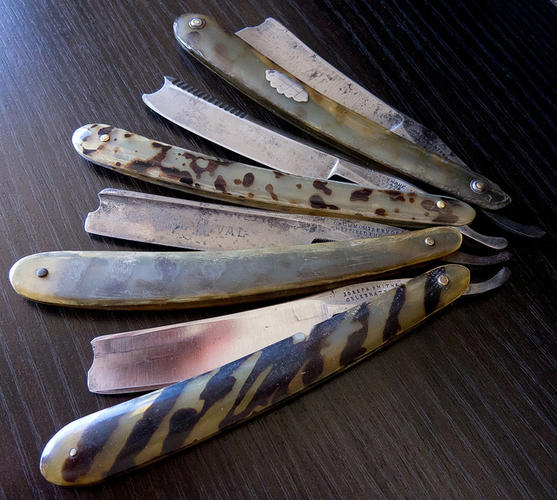
I had originally assumed all of these were dyed horn.
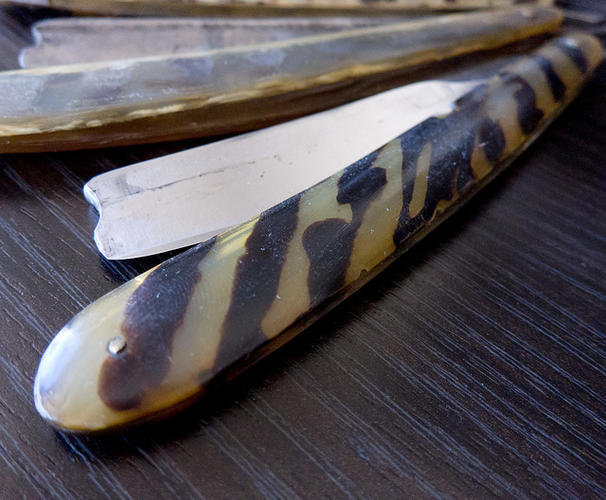
This one surely is.
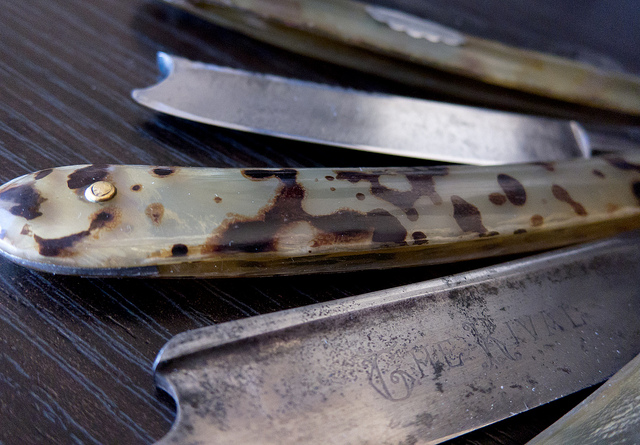
Pretty sure this is too.
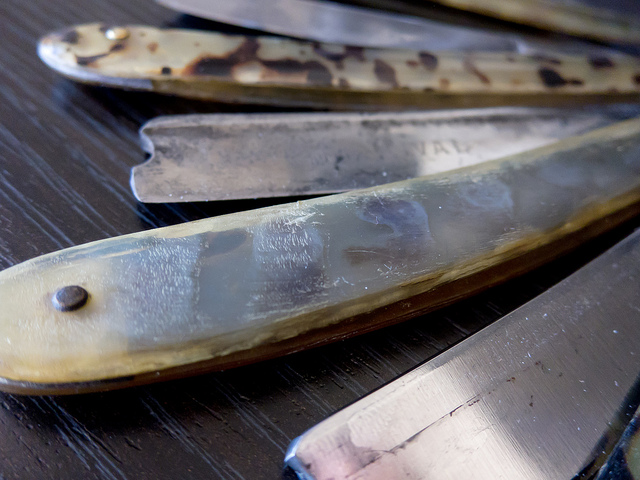
This 'new' one, I'm not so sure about.
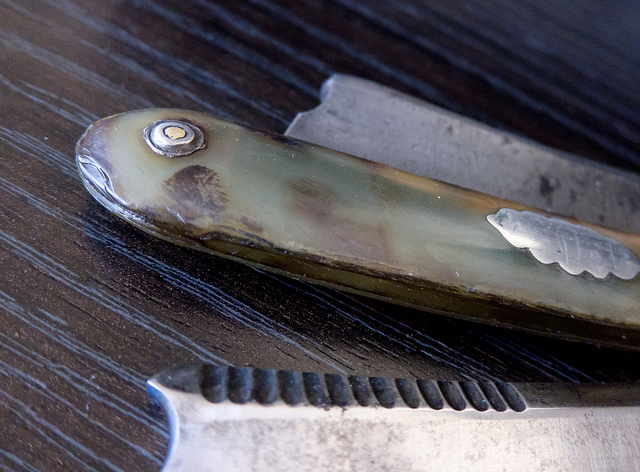
Which leaves me wondering about this one. Notice how the wavy crack at the end conforms to the shape of the dark spot? As though that dark spot were an organic part of the material?
The one that I can be sure of, I can be sure of because it's broken enough that I can see that the spots go 'through' the material to a degree. I haven't taken any of these apart yet, but the last one there -- the one with the silver plate -- it's got delamination of a sort I've never seen with horn, and the grain has a great deal more 'swirl' to it than other pieces of horn scale I've examined.
The thing that got my attention with the Crown Cutlery blade was that the dark spots are a tiny bit raised and have different texture.-Zak Jarvis. Writer. Artist. Bon vivant.
-
01-26-2012, 09:04 PM #2Senior Member



- Join Date
- Apr 2008
- Location
- Essex, UK
- Posts
- 3,816
Thanked: 3164
Sadly I don't think that any of them are real tortoiseshell.
Historically, they used to make a mixture of caustic soda (soap lye) and white lead mixed together with urine (!) and put it on the horn in little pellets, then weaken it and paint it on in other areas that were not to be affected as much. The horn was left until the pellets were quite dry, when it was found to resembel tortoiseshell. The darker, blacker colours had all sorts of chemicals mixed with colouring agents - vineger, acids, mercury, silver chloride, etc, and really penetrated the horn.
The patterns depended on how good the artist was - some evidently just 'splodged' the mixture on. Maybe the action of the chemicals raises the grain where it is applied - I haven't really looked out for that before.
Horn was used because it is so similar in composition to tortoiseshell - both are thermoplastic and can be moulded, shaped, bent and fused together with heat. The imitation was so popular at the time they called it 'mockshell' to distinguish it from the real article. Once made into shape, the mockshell was finished by polishing it with tripoli mixed with linseed oil.
The hot pin test can't even tell them apart - both produce the characteristic burnt smell.
I might be wrong of course, but I think they are horn.
Regards,
Neil
The tortoiseshell that I have handled has a more homogeneous look to it.Last edited by Neil Miller; 01-26-2012 at 09:07 PM.
-
The Following 6 Users Say Thank You to Neil Miller For This Useful Post:
32t (01-28-2012), engine46 (02-16-2015), JP5 (08-17-2015), Slartibartfast (01-26-2012), Theseus (01-26-2012), Voidmonster (01-26-2012)
-
01-26-2012, 09:31 PM #3

Excellent info, thank you!
Considering that horn and shell are both laminar keratin, I'd expect it to be very difficult to tell the difference... I would've thought the main indicator would be growth pattern, but considering the manipulation that's happening to get horn into the shape of scales in the first place, I guess I shouldn't be surprised that'd be seriously obscured!
I think you're probably right, that they're all horn. Looking at them all under a loop with very strong light, all the color variations are very shallow (even on the busted up scales I was pretty sure were genuine tortoise).
That leaves me to guess that the pretty obvious difference between the two 'types' in the pictures up there are probably just the skill of the scale maker. They're all from pretty widely varying time periods, and newer doesn't seem to equate to 'better' or 'worse' here. The one that got me to post this -- Crown Cutlery -- was made after 1891 ('Sheffield, England' stamp), the other with a similar appearance is an 1850's Joseph Smith & Sons, and one of the ones with the really obviously 'mockshell' scales is another Joseph Smith & Sons, probably 1880's.
Process is one of my main fascinations, so it's awesome to learn how these were made!
I'm just glad people aren't still using lant to preserve pastries.-Zak Jarvis. Writer. Artist. Bon vivant.
-
01-27-2012, 09:03 AM #4

A question or 3 , maybe for Neil.
Altho the hot pin may be inconclusive, does real shell smell different to horn when rubbed or sanded ?
Do the dark colours on real shell fade like some of the examples above?
I thought the above pics look like blonde horn but are there pics of T/shell that look like horn ?The white gleam of swords, not the black ink of books, clears doubts and uncertainties and bleak outlooks.
-
01-27-2012, 02:15 PM #5Senior Member



- Join Date
- Apr 2008
- Location
- Essex, UK
- Posts
- 3,816
Thanked: 3164
I have just tried the test, and the horn scales I have give off a smell much more readily than the tortoiseshell when rubbed. The tortoiseshell gave off a very faint smell, similar to horn, which smells a bit like burnt hair or nails to me. However, the surface finish of the tortoiseshell may have affected the results, and as I only have one example to try it is a bit of an unconclusive test again!
There is quite a range of color in tortoiseshell - in the past the lighter, honeyed/amber/orange was favoured and the darker type was cheaper. The light yellow type was called 'blonde' in the trade, the amber type 'demi-blonde' - the shell from the creatures belly is of the blonde/demi-blonde type with virtually no mottling, or anywhere in between. The mottled type is from the creatures back - it can be strikingly mottled with light and dark areas or almost one shade of dark brown. I have only seen the darker mottled type used for razor scales, but I suppose the pale type can look just like horn.
Because blonde shell was an expensive luxury, cowhorn was boiled in water with nitric acid added to it to render it yellow. It was then used just like that or subjected to the mottling and painting techniques.
Because it is of the same structure as cowhorn it shares the same thermoplastic nature and metal shapes could be heated and pressed into the shell - silver was used a lot, particularly in the form of small pins ('pique-work').
I suppose the only positive test would be a destructive one - the mottling in tortoiseshell goes virtually right through the material, whereas in horn it is mainly on and just below the surface which means that a section through the material (or a fair bit of sanding in the case of horn) should identify it one way or the other.
Regards,
NeilLast edited by Neil Miller; 01-27-2012 at 02:18 PM.
-
The Following 6 Users Say Thank You to Neil Miller For This Useful Post:
32t (01-28-2012), engine46 (02-16-2015), hoglahoo (01-27-2012), onimaru55 (01-28-2012), str8fencer (01-27-2012), Voidmonster (01-27-2012)
-
01-30-2012, 02:00 PM #6

Donít feel bad Voidmonster, Iíve made the same mistake. Itís hard to tell them apart depending on the skill of artist like Neil said.. I keep a sample of tortoise shell for comparison.
Mike

Last edited by MODINE; 01-30-2012 at 02:01 PM. Reason: remove pic


 7Likes
7Likes LinkBack URL
LinkBack URL About LinkBacks
About LinkBacks







 Reply With Quote
Reply With Quote

